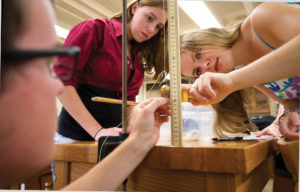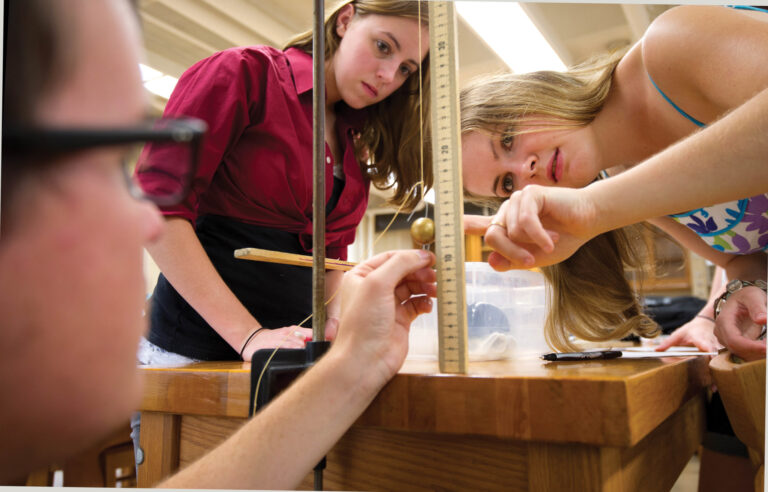Near the end of his life, the great 20th century theologian and philosopher Francis Shaeffer summarized the entirety of his thought in a book entitled with the question that serves as the title of this essay. I think our Sixth and Seventh Great Commitments provide Berea College’s answer to that question.
Sixth: “To create a democratic community dedicated to education and equality for women and men.”
Seventh: “To maintain a residential campus and to encourage in all members of the community a way of life characterized by plain living, pride in labor well done, zest for learning, high personal standards, and concern for the welfare of others.”
We sometimes simplify these as the commitments to co-education and sustainability, but there is much more than that here. The Sixth Great Commitment pairs with the Fifth – the interracial commitment – in proclaiming that the inclusive goals of Berea’s founding mean everyone, black and white, male and female, is deserving of education. Also, the phrasing of the Sixth Commitment wonderfully connects the goals of co-education to the principles of democracy as a foundation for our academic community.
Here, as in other areas, Berea College significantly anticipated societal developments in our nation. Our commitment to the education of women substantially preceded national movements for women’s political equality. The 19th Amendment to the U.S. Constitution (women’s suffrage) was drafted in 1878, almost 20 years after Berea was formally incorporated, but it was not approved by Congress and sent to the states for ratification until 1919. The states took only one year to ratify the amendment, and it was added to the Constitution in 1920 when Tennessee became the 36th state to ratify it. (Kentucky was the 23rd state to ratify the amendment, and I would be interested to learn if Berea College played a role in that.) Still, ratification came more than 60 years after our founding and 50 years after Berea formed its first college class in 1869, consisting of four young men and a young woman. By 1874, Ladies Hall (now called Fairchild) had been built to accommodate 96 female students.

One more observation from history, then on to the present. The motivation for coeducation may have been Berea founder John G. Fee’s vision of impartial love, but when President Edward Henry Fairchild presented the idea to the public, he did so with a social utilitarian argument in which women functioned rather like moderators in a nuclear power reactor. “Rowdyism,” he said, was “the natural result of separating young men from the society of ladies,” and he thought it “almost unknown and impossible in a school of both sexes.” I suspect this line of argument was necessary to persuade skeptics that the College was right to admit females. Certainly, female students did much more than temper the behavior of rowdy young males. Right from the start, female graduates had a major impact in the region, taking on the lion’s share of teaching and nursing positions that were urgently needed throughout Appalachia. Clearly, our Founders were ahead of their time in understanding something that is obvious to us now – that a mixed-gender community is a better learning environment for men and women, just as an interracial community is better for all members.
So, how are we doing today? Currently, female students both outnumber and outperform male students at Berea (and at many other selective colleges as well), so I guess that we males should be relieved that the phrasing of the Sixth Commitment covers men, too.
In terms of the other constituencies that make up our community – faculty and staff – we have achieved rough parity. Still, other challenges remain. On the Board of Trustees, we have 10 women and 22 men serving, which though quite good relative to the boards of similar institutions, is not the balance that we are seeking to achieve at Berea. In terms of faculty and institutional leadership through the governance structure, women and men share the positions and responsibilities fairly equally. For example, the Administrative Committee, which is responsible for matters of finance, physical properties and internal management of the College, currently has three women as part of its eight-person membership. Not wanting to leave the obvious unsaid, Berea has not yet had a female president. Our run of nine consecutive white-male presidents is, of course, statistically improbable – the odds of that happening randomly are only about 1 in 500. I gather, however, that the most recently concluded search had strong representation of both genders in the pool of candidates, so perhaps those odds are changing.
Living out our inclusive mission and being the best educational community we can be requires a commitment to a democratic community and to gender equality.
But How Else Should We then Live?
The Seventh Commitment has been referred to by some as the “kitchen sink,” because it does indeed cover a lot of ground – plain living, pride in our work, zest for learning, high standards and concern for the welfare of all.
Often we focus on the “plain living” phrase, wondering what can that possibly mean for living in the complex 21st century. We must interact with a highly connected and technological society, and the global aspects of those connections have more and more significance for Bereans everywhere.
The phrase is inspired by tradition and a largely self-sufficient way of life that prevailed in our Appalachian region before the advent of widespread resource extraction activities, particularly the coal and timber industries.
It is important to remember that Appalachian-style “plain living” was by no means simple. James Still’s novel, River of Earth, talks about the dislocation of lives that occurred as a result of the advent of coal mining. The disruption was not that the mines destroyed the land or the streams (that came later), but that when men went down into the mines, they could not do the year-round set of carefully orchestrated activities required for a subsistence agricultural life to succeed. If you didn’t plant in the spring, you couldn’t harvest in the fall, and there was a great deal of highly specialized knowledge that made it all work.
So, the advent of mining had two effects. First, in a single generation, that lore was lost. More importantly, due to its immediate effect on lives, was the cyclical nature of work in the mines. It was fine, financially, while the work lasted; the pay enabled a more plentiful lifestyle for families, but when layoffs occurred or mines closed and the operations moved to another location, families could not fall back on their former lifestyle, because it could not be pursued for just part of the year. Eventually, the “coal town” was invented, which led to another sort of vulnerability.
So plain living’s distinguishing feature has never been simplicity. Rather, sustainability is a more apt characterization. The lifestyle could be sustained over generations because of its low impact on the land, and because the knowledge needed to maintain it could be passed along from one generation to the next. The evolution of resource extraction industries in Appalachia has often been antithetical to this vision – large-scale, clear-cutting of forests can damage ecosystems for generations and mountaintop removal mining is the very epitome of environmental destruction.
How, Then, Should we Live? Certainly Not That Way?
So, it is consistent with the Seventh Commitment that at Berea we have an emphasis on sustainability that extends from our building practices to the way we handle our waste streams, to our local and organic farming operations, to managing our forest assets, to rolling all of that into the educational experience of our students, so they can take those attitudes and practices with them wherever they go.
But the Seventh Commitment and the question of “how, then, should we live” go well beyond environmental sustainability. There is sustainability of our health and well-being (we call it wellness); there is sustainability of our economic lives (financial literacy); there is sustainability of our political lives (civic participation); there is sustainability of our social fabric, which we develop by maintaining a residential campus community that enables us to work and serve with people from a variety of cultural backgrounds and personal experiences.
In short, the Sixth and Seventh Great Commitments are a profound statement about the ethics of personal and institutional choice. I am proud, as I believe we all are, to be part of a college that signals in its mission statement how ethical choice is foundational to education and community. Berea’s history of lifting up democratic ideals that precede societal standards, as in our early adoption of coeducation and our embrace of sustainability long before that became ubiquitous, defines how we as a College choose to exist and characterizes the transformational education we offer our students.


